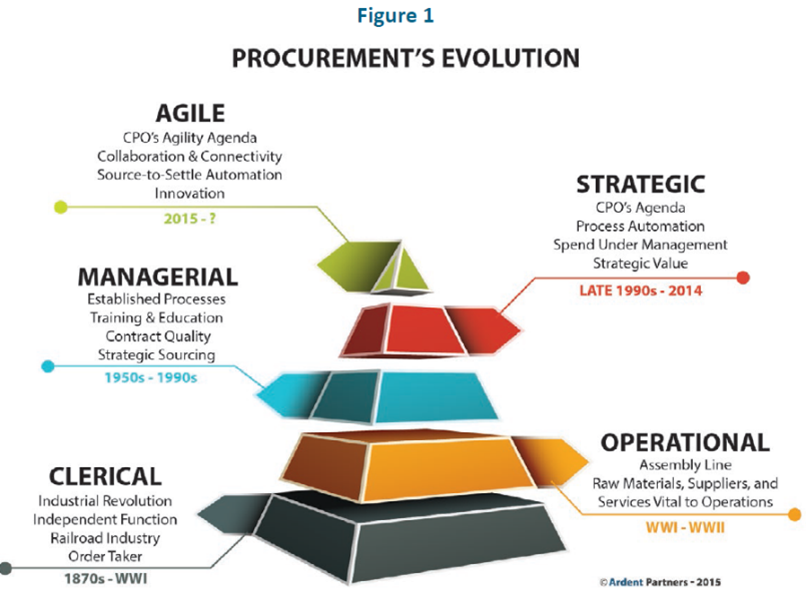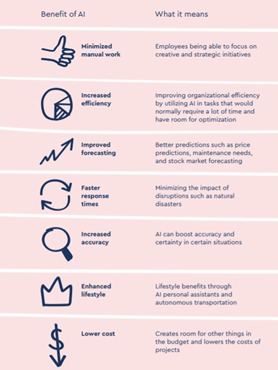
(originally published May 2021) In March 2015, Ardent Partners published their annual CPO Rising study. That year, the study announced an official shift into the next phase of evolution from a Strategic to an Agile procurement organization. The top three (3) priorities for Chief Procurement Officers in 2015 were:
1. Improve collaboration within the lines of business
2. Implement stronger policies and processes
3. Improve the use of technology
Ardent Partners summarized, “The procurement teams that adeptly connect their tools, resources, and expertise to support the evolving needs of the business will succeed above all others. Agility will define the next wave of procurement success.”
The new ‘agile organization’ was coined to define the organization’s ability to quickly adjust to the changing needs of the consumer. A renewed energy by the organization was focused on digital transformation programs. The intent was to bring automation to manual activities and enable the organization to share information globally. While the agile organization made significant progress towards the goals outlined in the CPO study, automation alone was not able to realize the priorities fully. In 2021, the following gaps still exist:
– Lack of confidence in procurement and supply chain data
– Lack of visibility in evaluating supplier risks
– Inaccuracy in data limits the ability to make actionable decisions in a time frame when those decisions have the most impact
– Regardless of automation, users still perform tactical level activities
AI in Procurement
Cognitive technology is a term used to group the science behind artificial intelligence encompassing machine learning (neural networks and deep learning), natural processing language (sentiment analysis and grammar-based semantics), robotics, and more. It aims to augment day-to-day activities by solving problems and answering questions most commonly requiring the human thought process. The goal is to shift resources into more value-added roles while enabling cognitive technologies to take over repeatable tasks, analyze large amounts of data quickly, and improve the decision-making process in a shorter period of time.
In some areas of your day-to-day procurement and supply chain work life, you may have already been using AI or exposed to the results of AI, but are not fully aware of it. For example, in 2005, Ariba purchased a patented grammar-based, natural processing language (NML), from Softface Inc. If you have purchased the Ariba Spend Visibility solution, those AI capabilities are used during the data classification, supplier normalization, and data enrichment process.

Today, spend analytics solutions have continued to fold in the latest advances in deep learning and neural networks. Creactives, an Italian company, has further evolved its applications to process data in 25+ languages, minimize the need for human interaction, and proactively outline opportunities to keep your data clean.
Seal Software, founded in 2007, has a “proven combination of AI technologies, including NML and machine learning to read and extract meaningful data (attributes) from Contract documents.
Are you using Jaggaer’s Supply Chain software? It also uses “…machine learning technologies to provide predictive analytics and recommend actions based on real-time data”. Its use of neutral networks recognizes patterns of the supplier and aims to provide insights into “reducing risks of production downtimes, delayed deliveries, and increased costs”.
The logistics company, Cainiao, uses AI to find the most efficient delivery routes for its logistics, which has resulted in a 10% reduction in-vehicle use. (Sennaar, Kumba Feb 18, 2019 – Artificial Intelligence in eCommerce.
SAP recently encouraged its partners to develop BOTs to automate small, repeatable, manual tail-end tasks still lingering across its integrated suite of cloud products. These are just a few examples of AI in procurement, but certainly not a comprehensive list.
While AI continues to find more ways to augment our procurement and supply chain processes, the use of AI is changing the evolutionary journey of the procurement and supply chain organization.
“I expect AI will will change 100% of the jobs in the next 5-10 years”
2019, CEO IBM
The New ‘Intelligent’ Procurement Organization
“When procurement and supply chain can embrace AI and cognitive technologies, to evolve into a better-informed, decision-based organization, only then can the procurement goals be fully realized. The intelligent organization will be the next wave of procurement success”, Melissa Drew (2021)
In shifting from an agile to an informed or intelligent organization, using cognitive technologies, there will be some growing pains. Additional time is required to consider and talk through some key decisions. A few examples may include:
1. What skill sets do procurement and supply chain teams need in the next 2-3 years?
2. What is the role of the company to educate those team members?
3. How will the role of procurement & supply chain organizations change?
4. How will the role of the chief procurement officer evolve alongside new roles such as Chief Data Officer and Chief Information Officer?
5. Who will take lead and ownership of future digital business transformation?
This is an exciting time for procurement and supply chain and it is just the beginning.
